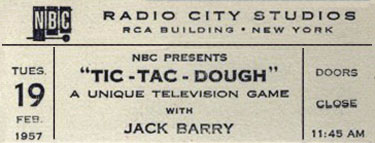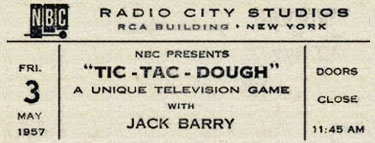Tic-Tac-Dough (1956-1959)



Tic-Tac-Dough had a long, checkered history. Produced and originally hosted by Jack Barry, it debuted on NBC daytime on July 30, 1956. Barry was busy with his company’s prime-time hit and he eventually handed hosting chores off to Gene Rayburn. Announcing Legend Bill Wendell was the announcer and when Rayburn moved on in 1958, Wendell took over as host, continuing until this run of the show did its final broadcast on October 23, 1959. A prime-time version, hosted by Jay Jackson and later by Win Elliot, ran from September 12, 1957 until December 29, 1958.
What killed Tic-Tac-Dough was the scandal that Barry and his line producer, Dan Enright, were rigging their shows. Most of the outrage was over their other prime-time series, Twenty-One, but there was plenty of evidence that the outcome of many a game of Tic-Tac-Dough was prearranged. In particular, a Tic-Tac-Dough contestant named Kirsten Falke was subpeonaed by a government investigation and she admitted that one of the show’s producers, Howard Felsher, coached her on how to win and gave her answers in advance. The prime-time version was yanked off the air but NBC attempted to keep the daytime version around for a time, swearing that it had been cleaned up and was now on the level. It may have been but audiences stopped watching. Perhaps they didn’t believe that the show was now honest or maybe it just reminded them how they’d been deceived.
But that was not the end of Tic-Tac-Dough. It came back in a daytime version on CBS in 1978 and when that was cancelled, it shifted to syndication where it had a long and healthy run from 1978 through 1986. It then came back again for a brief run in 1990.
How did one play Tic-Tac-Dough? Simple. Two contestants competed, one designated as “X” and one designated as “O,” just as in tic-tac-toe. Each of the nine boxes on a tic-tac-toe grid had a category assigned to it and a player could “win” that box by correctly answering a question in that category. Get three in a row and you win. It was very simple, which perhaps explains the game’s long run.






